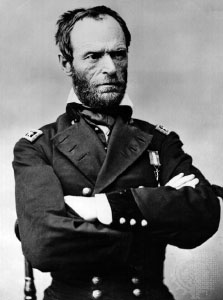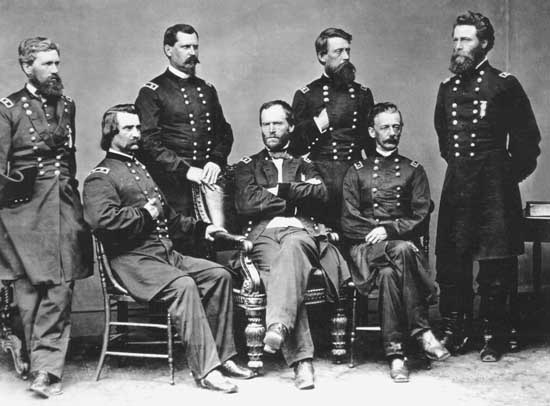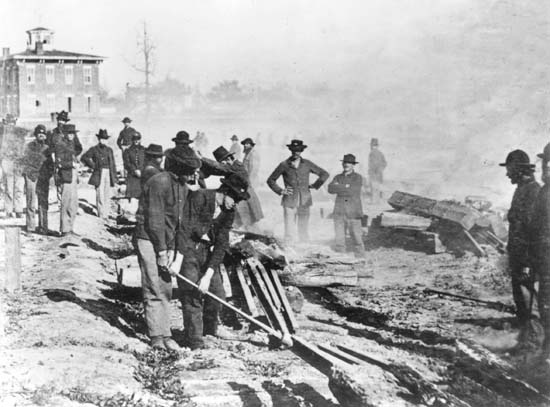Sherman, William Tecumseh
United States general
Introduction
born February 8, 1820, Lancaster, Ohio, U.S.
died February 14, 1891, New York, New York
 American Civil War general and a major architect of modern warfare. He led Union forces in crushing campaigns through the South, marching through Georgia and the Carolinas (1864–65).
American Civil War general and a major architect of modern warfare. He led Union forces in crushing campaigns through the South, marching through Georgia and the Carolinas (1864–65).Early life and career
Named Tecumseh in honour of the renowned Shawnee chieftain, Sherman was one of eight children of Judge Charles R. Sherman, who died when the boy was only nine. Thomas Ewing, a family friend and a Whig political force in Ohio, adopted the boy, and his foster mother added William to his name. When Sherman was 16, Ewing obtained an appointment to West Point for him. Sherman graduated near the head of his class in 1840.
After graduation Sherman was sent to fight Seminole Indians in Florida and was eventually transferred to Fort Moultrie, South Carolina. The Mexican War, in which so many future generals of the Civil War received their experience, passed Sherman by; he was stranded in California as an administrative officer. In 1850 he married Ellen Ewing, daughter of his adoptive father, who was then serving as secretary of the interior in Washington. They settled in St. Louis, Missouri. The lure of gold in California led Sherman to resign from the U.S. Army in 1853 and join a St. Louis banking firm at its branch in San Francisco. The Panic of 1857 interrupted his promising career in business, however, and after several more disappointments, his old friends, the Southerners Braxton Bragg (Bragg, Braxton) and P.G.T. Beauregard (Beauregard, P.G.T.), found him employment (January 1860) as superintendent of a newly established military academy in Louisiana. When Louisiana seceded from the Union in January 1861, Sherman resigned his post and returned to St. Louis. His devotion to the Union was strong, but he was greatly distressed at what he considered an unnecessary conflict between the states. He used the influence of his younger brother, Senator John Sherman, to obtain an appointment in the U.S. Army as a colonel in May 1861.
Civil War (American Civil War) years
Sherman was soon assigned to command a brigade in General Irvin McDowell's army, and he fought in the disastrous first Battle of Bull Run (Bull Run, battles of) (July 21, 1861). Though afterward promoted to brigadier general, he was convinced by his experience at Bull Run that he was unfit for such responsibility, and he begged President Abraham Lincoln (Lincoln, Abraham) not to trust him in an independent command. Lincoln nevertheless sent Sherman to Kentucky as second-in-command under General Robert Anderson. In October 1861 Sherman succeeded to the command in Kentucky, but he was nervous and unsure of himself, and his hallucinations concerning opposing Confederate forces led him to request so many reinforcements from his superiors that some newspapers described him as insane. He lost his Kentucky command, but with the support of General Henry Halleck (Halleck, Henry W), he then served as a divisional commander under General Ulysses S. Grant (Grant, Ulysses S.). Sherman distinguished himself at the Battle of Shiloh (Shiloh, Battle of) (April 6–7, 1862) and won promotion to the rank of major general.
Grant had a calming influence upon Sherman. Together they fought brilliantly to capture Vicksburg (Vicksburg Campaign), Mississippi (1862–63), shattering the Confederate defenses and opening the Mississippi River to Northern commerce once more. Though Sherman began his part in the campaign with a defeat at Chickasaw Bluffs, his capture of Fort Hindman, Arkansas, served to restore his reputation. In Grant's final Vicksburg campaign Sherman commanded the 15th Corps.

 Sherman's star, along with Grant's, was now in the ascendant, and their careers were thenceforth closely linked as they worked together to bring about a Union victory in the war. When Grant was placed in supreme command in the west, Sherman succeeded to the command of the Army of the Tennessee and in that capacity took part with Grant in the Chattanooga campaign in November 1863. In March 1864, when Grant became general-in-chief of the Union armies, Sherman was made commander of the military division of the Mississippi, with three armies under his overall command. Assembling about 100,000 troops near Chattanooga, Tennessee, in May 1864, he began his invasion of Georgia. The opposing Confederate forces led by General Joseph E. Johnston (Johnston, Joseph E) retreated slowly ahead of him, and on September 2, 1864, Sherman's forces were able to occupy Atlanta (Atlanta Campaign), a vital industrial centre and the hub of the Southern railway network. The Union war effort was not proceeding well in the east, and Sherman's capture of Atlanta was a much-needed victory that restored Northern morale and helped ensure Lincoln's reelection that November.
Sherman's star, along with Grant's, was now in the ascendant, and their careers were thenceforth closely linked as they worked together to bring about a Union victory in the war. When Grant was placed in supreme command in the west, Sherman succeeded to the command of the Army of the Tennessee and in that capacity took part with Grant in the Chattanooga campaign in November 1863. In March 1864, when Grant became general-in-chief of the Union armies, Sherman was made commander of the military division of the Mississippi, with three armies under his overall command. Assembling about 100,000 troops near Chattanooga, Tennessee, in May 1864, he began his invasion of Georgia. The opposing Confederate forces led by General Joseph E. Johnston (Johnston, Joseph E) retreated slowly ahead of him, and on September 2, 1864, Sherman's forces were able to occupy Atlanta (Atlanta Campaign), a vital industrial centre and the hub of the Southern railway network. The Union war effort was not proceeding well in the east, and Sherman's capture of Atlanta was a much-needed victory that restored Northern morale and helped ensure Lincoln's reelection that November.
 Union superiority in manpower was now having its effect, and Sherman was able to detach part of his army and lead the remaining 62,000 troops on the celebrated “March to the Sea” from Atlanta to Savannah on the Atlantic coast. Separated from its supply bases and completely isolated from other Union forces, Sherman's army cut a wide swath as it moved south through Georgia, living off the countryside, destroying railroads and supplies, reducing the war-making potential of the Confederacy, and bringing the war home to the Southern people. Sherman reached Savannah in time for Christmas and “presented” the city to Lincoln with 150 captured cannons and 25,000 bales of cotton. By February 1865 he was heading north through the Carolinas toward Virginia, where Grant and the Confederate commander General Robert E. Lee (Lee, Robert E.) were having a final showdown. The opposing Confederate forces led by Johnston could offer Sherman only token resistance by now. Lee surrendered to Grant in Virginia on April 9, and Johnston surrendered the remnants of his forces to Sherman on April 26 near Durham, North Carolina.
Union superiority in manpower was now having its effect, and Sherman was able to detach part of his army and lead the remaining 62,000 troops on the celebrated “March to the Sea” from Atlanta to Savannah on the Atlantic coast. Separated from its supply bases and completely isolated from other Union forces, Sherman's army cut a wide swath as it moved south through Georgia, living off the countryside, destroying railroads and supplies, reducing the war-making potential of the Confederacy, and bringing the war home to the Southern people. Sherman reached Savannah in time for Christmas and “presented” the city to Lincoln with 150 captured cannons and 25,000 bales of cotton. By February 1865 he was heading north through the Carolinas toward Virginia, where Grant and the Confederate commander General Robert E. Lee (Lee, Robert E.) were having a final showdown. The opposing Confederate forces led by Johnston could offer Sherman only token resistance by now. Lee surrendered to Grant in Virginia on April 9, and Johnston surrendered the remnants of his forces to Sherman on April 26 near Durham, North Carolina.Sherman remained a soldier to the end, though his view of warfare was succinctly put in his oft-quoted assertion that “war is hell.” When Grant became a full general in 1866, Sherman moved up to the rank of lieutenant general, and when Grant became president in 1869, he made Sherman commanding general of the army, a post he held until 1884. Unlike Grant, Sherman declined all opportunities to run for political office, saying he would not run if nominated and would not serve if elected. He died in New York City in 1891.
Sherman was one of the ablest Union generals in the Civil War. He saw that conflict in its broadest strategic terms, and his March to the Sea is generally regarded as the first example of the use of total war in the modern era.
Additional Reading
Lloyd Lewis, Sherman: Fighting Prophet (1932, reissued 1993), was for years the standard work on Sherman. James M. Merrill, William Tecumseh Sherman (1971), utilized Sherman letters not available to Lewis. More recently a flurry of Sherman biographies have fleshed out this important Civil War figure. Books in this later category include, in ascending order of merit, Stanley P. Hirshson, The White Tecumseh: A Biography of General William T. Sherman (1997); Michael Fellman, Citizen Sherman: A Life of William Tecumseh Sherman (1995); and John F. Marszalek, Sherman: A Soldier's Passion for Order (1993). Joseph Glatthaar, The March to the Sea and Beyond: Sherman's Troops in the Savannah and Carolinas Campaigns (1985, reissued 1995), analyzes Sherman's campaigns through Georgia and the Carolinas.
- Garter, The Most Noble Order of the
- Garth Brooks
- Gartok
- Garuḍa
- Garvey, Marcus
- Gary
- Gary Ablett
- Gary Cooper
- Gary, Elbert Henry
- Gary Gabelich
- Gary Player
- Gary, Romain
- Gary S. Becker
- Gary Snyder
- Garção, Pedro António Correia
- gas
- gas burner
- gas chamber
- gas chromatography
- Gascoigne, George
- Gascon, Jean
- Gascony
- Gascoyne, David
- Gascoyne River
- Gas Hills